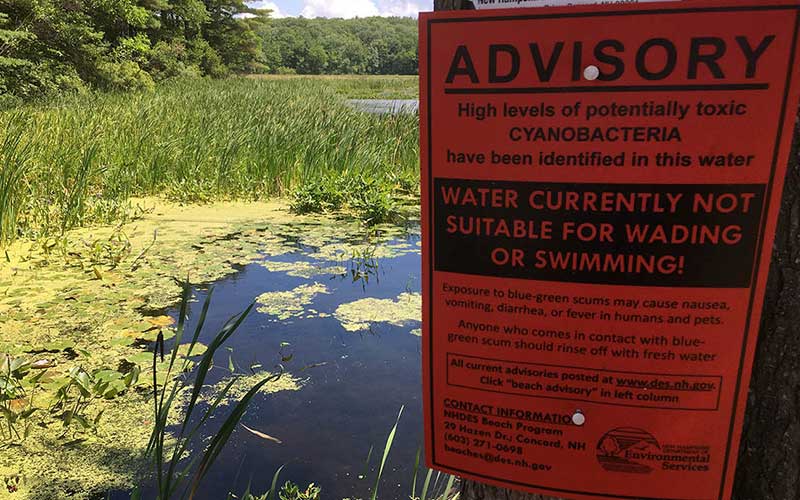
Blue-green algae spoils swimming spots across New England. Photo: CLF
For me, a beautiful summer day means enjoying my sailing membership at Community Boating on the Charles River Esplanade in Boston. But I lost out on an afternoon ride on the river a couple of times last summer. As I approached the boathouse, I consulted the Community Boating website to find that the toxicity levels in the Charles were dangerous for recreation. The Charles River Watershed Association’s helpful reporting kept me from the river those days.
After a big storm, stormwater and sewage sometimes overload our sewer system. This triggers a “combined sewer overflow,” which dumps industrial wastewater and untreated sewage into bodies of water – including the Charles. This can spark outbreaks of toxic blue-green algae.
Toxic blue-green algae (also known as cyanobacteria) are naturally occurring organisms. But when too much nutrient pollution from untreated sewage and runoff contaminates warm waters, the algae can grow out of control. Blooms of toxic algae form a thin blue-green layer of scum on the surface of the water. Contact with the algae can cause stomachaches, neurological symptoms, and other illnesses in humans. In animals, it can be fatal.
This toxic algae thrives in heat. So as the climate crisis warms our waters and storms lead to even greater contributions of nutrient pollution, blue-green algae outbreaks increase – it’s a toxic mix.
CLF and other organizations across New England are promoting transparency about this issue. For example, as part of the Massachusetts Rivers Alliance, CLF successfully championed a sewage notification law that now requires the state to notify the public when untreated sewage enters our waterways.
Beach Closures Due to Blue-Green Algae Outbreaks
Living in New England, you’ve probably experienced a beach closure or two.
As our summers become warmer due to climate change, outbreaks of toxic blue-green algae are increasing in New England’s ponds and beaches – closing our beaches and poisoning our shellfish. Massachusetts reported at least 70 beach closures in 2023 due to blue-green algae outbreaks.
In New England, we struggle with nutrient runoff from our fertilizers and farms and pollution from wastewater treatment plants (including those gross sewer overflow events). As a result, we have outbreaks of dangerous blue-green algae.
CLF’s Battles Toxic Algae in New England Waters
CLF is fighting for regulations to control stormwater runoff and prevent toxic algae outbreaks across New England. Runoff from paved commercial businesses and industrial activities is contributing to toxic algae and nutrient pollution in local bodies of water.
But U.S. EPA and state environmental agencies are not currently regulating those kinds of stormwater discharge.
CLF has filed petitions to force regulators to act and protect our vulnerable water bodies by creating stronger regulations on local sources of runoff by implementing their Residual Designation Authority (RDA).
RDA allows these officials to issue permits under the Clean Water Act to regulate stormwater runoff, which is usually not managed by permits. The RDA permits would create legally binding requirements for owners of local impervious surfaces (surfaces like pavement that can’t absorb water) to protect water quality. These requirements range from increased water testing to storm drain designs. All of which protect local water bodies from the pollutants you find on pavement.
Once implemented, this process will create more effective regulations for local pollution sources.
CLF has an ongoing lawsuit against EPA seeking to force EPA to finally protect the Charles, Mystic, and Neponset Rivers from stormwater runoff by issuing and enforcing RDA permits. Holding authorities accountable for closely regulating facilities is the first step toward reducing toxic algae outbreaks.
CLF’s lawsuit against EPA demanding the implementation of RDA will continue this fall.
You Can Make a Difference!
As a novice sailor and beachgoer, I hope to be in a sunfish on the Charles River or swimming at a local beach this summer.
To safely enjoy this experience, I consult the Massachusetts Department of Health and Charles River Watershed Association as they report the river’s toxicity levels after heavy rainfall to warn against recreation. You can play a role in making sure that more people are informed about toxic algae events.
CLF needs your help this summer to find blue-green algae outbreaks in Massachusetts waterbodies. Toxic blue-green algae (also known as cyanobacteria) are naturally occurring organisms. But when too much nutrient pollution is added to warm water, they grow out-of-control in a thin blue-green layer of scum on top of the water. Contact with the algae can cause stomach aches, neurological symptoms, and other illnesses.
This summer, CLF needs your help to find out the dates and locations of toxic blue-green algae outbreaks in Massachusetts waters.
How do I tell if it’s blue-green algae?
You’ll see:
- Blue-green, green, or brownish scum covering the water’s surface
- Globs of thick algae
- Foam at the edges of the water
If you see blue-green algae:
On the Charles River: take a photo and contact the Charles River Watershed Association following the steps listed here.
On other Massachusetts waters: fill out this form to help us take action!



